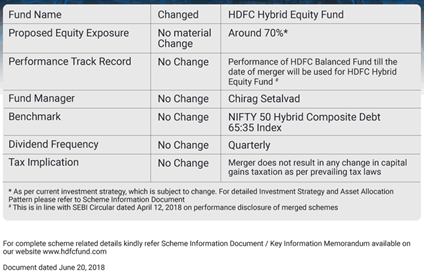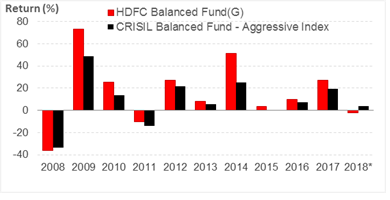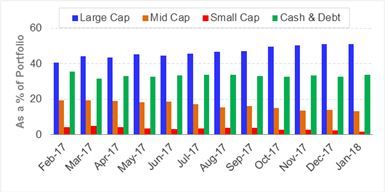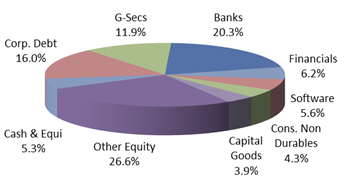HDFC Balanced Fund is among the few well-managed funds from the stable of
HDFC Mutual Fund. Launched nearly two decades ago, the fund has consistently outperformed the benchmark across market periods, while maintaining a tab on risk. The fund boasts of a stable fund management, with Mr Chirag Setalvad being at the helm for over a decade.
With the equity market rally over the past few years, investors would be tad disappointed with the fund's returns. Over the past year, ended February 21, 2018, HDFC Balanced Fund generated a return of 16.31% in comparison to its benchmark return of 17.13%.
The longer-term returns of the fund are more encouraging. Over the longer periods of 3-years and 5-years, HDFC Balanced Fund has outpaced the Crisil Balanced Fund Index by a decent margin with returns of 10.76% and 18.92% respectively. The index generated a return of 8.19% and 12.12% over the same period.
Could the recent underperformance of the fund be due to its burgeoning corpus? Over the past couple of years, the corpus of HDFC Balanced Fund has doubled in each year. The balanced fund's corpus more than doubled to Rs 9,508 crore as in February 2017 from Rs 4,695 crore in February 2016. In the past year, the fund corpus again doubled to Rs 20,081 crore in January 2018.
As far as the AUM of mutual fund houses is concerned, PersonalFN is of the view that the size of a mutual fund schemes doesn't tell you anything about its future performance. The key to a fund's performance lies in its investment style, which is also a factor of the fund manager's experience and investment processes followed by the fund house.
It is best to assess whether the AUM growth is causing changes to the investment style. Some changes may be in the interest of the investors and some may not. Act before any changes materialise as a disappointing performance.
HDFC Balanced Fund has often ranked among the top decile performers in the balanced funds category. Its performance in the past over certain periods has even put more aggressive large-cap funds to shame. The aggressive hybrid fund not only boasts of a lower volatility compared to its peers, but has delivered even stronger returns in comparison.
In this brief analysis, PersonalFN takes a close look at the features and performance of HDFC Balanced Fund.
Investment Objective of HDFC Balanced Fund
HDFC Balanced Fund has an investment objective to "generate capital appreciation along with current income from a combined portfolio of equity & equity related and debt and money market instruments."
HDFC Balanced Fund Details
Fund Facts
| Category |
Balanced Funds |
Style |
Blend |
| Type |
Open ended |
Market Cap Bias |
Multi-cap |
| Launch Date |
20-Sep-00 |
SI Return (CAGR) |
16.68% |
| Corpus (Cr) |
Rs 20,081 |
Min./Add. Inv. |
Rs 5,000 / Rs 1,000 |
| Expense Ratio (Dir/Reg) |
0.80% / 1.95% |
Exit Load |
1% |
Data as on January 31, 2018.
SI Return as on February 22, 2018.
(Source: ACE MF)
Under normal circumstances, the HDFC Balanced Fund will allocate…
- 40% - 80% of its assets in equity & equity related instruments.
- 10% - 70% in Debt Securities (including securitised debt) and Money Market Instruments.
Growth Of Rs 10,000, If Invested In HDFC Balanced Fund 5 Years Back
 Data as on February 22, 2018 Data as on February 22, 2018
(Source: ACE MF)
|
Had you invested Rs 10,000 in HDFC Balanced Fund, 5 years back on February 22, 2013, it would have grown to Rs 23,789. This translates in to a compounded annualised growth rate of 18.91%. In comparison, a simultaneous investment of Rs 10,000 in an alternate benchmark (Price data of CRISIL Balanced Fund not available) —CRISIL Hybrid 35:65 would now be worth Rs 18,562 (a growth of 13.16% CAGR).
|
The fund has clearly outperformed its benchmark over the period of last 5 years. Bulk of the outperformance came in 2014-15.
HDFC Balanced Fund: Year-on-Year Performance
|
HDFC Balanced Fund has a track record of over 15 years. The year on year performance comparison of the fund vis-à-vis its benchmark – CRISIL Balanced Fund shows that the fund has outperformed the benchmark in 9 out of last 10 calendar years. In 2008, when the financial crisis hit, the fund underperformed the benchmark when the market crashed.
In 2011, HDFC Balanced Fund proved its ability to limit losses during market correction. A large portion of its alpha was generated in the market rallies of CY 2009 and CY 2014. The returns have been subdued in the recent few years. For the year-to-date, the scheme has lagged the benchmark and delivered a negative return.
|
 YTD as on February 22, 2018 YTD as on February 22, 2018
(Source: ACE MF) )
|
HDFC Balanced Fund: Performance Vis-à-vis Category Peers
Rolling Period Returns
| Scheme Name |
Corpus (Rs Cr) |
1 Year |
2 Year |
3 Year |
5 Year |
Std Dev |
Sharpe |
| L&T India Prudence Fund |
9,578.0 |
21.26 |
13.64 |
16.26 |
19.03 |
9.72 |
0.13 |
| DSPBR Balanced Fund |
7,031.8 |
19.84 |
14.20 |
15.96 |
15.97 |
11.59 |
0.10 |
| HDFC Balanced Fund |
20,080.8 |
22.04 |
15.00 |
15.74 |
18.70 |
9.74 |
0.13 |
| Principal Balanced Fund |
1,018.5 |
27.97 |
18.10 |
15.58 |
17.56 |
11.64 |
0.17 |
| ICICI Prudential Balanced Fund |
27,840.0 |
22.22 |
15.68 |
15.48 |
18.99 |
9.70 |
0.14 |
| Aditya Birla SL Balanced '95 Fund |
14,085.4 |
19.61 |
14.21 |
15.34 |
17.87 |
10.04 |
0.09 |
| Reliance Reg Savings Fund-Balanced Option |
12,199.8 |
22.09 |
14.26 |
15.17 |
17.33 |
10.31 |
0.12 |
| SBI Magnum Balanced Fund |
21,024.5 |
17.01 |
11.52 |
14.29 |
18.38 |
8.97 |
0.09 |
| Franklin India Balanced Fund |
2,210.4 |
14.56 |
10.91 |
14.21 |
16.83 |
8.36 |
0.05 |
| Canara Robeco Balance Scheme |
1,549.0 |
19.32 |
12.05 |
14.15 |
16.28 |
11.59 |
0.06 |
| HDFC Prudence Fund |
39,431.2 |
23.85 |
15.10 |
13.89 |
17.20 |
12.80 |
0.09 |
| Tata Balanced Fund |
5,848.2 |
14.22 |
9.43 |
13.73 |
17.33 |
9.91 |
0.02 |
| Aditya Birla SL Balanced Advantage Fund |
3,266.0 |
18.24 |
15.56 |
13.08 |
14.10 |
9.11 |
0.08 |
| UTI Balanced Fund |
5,476.0 |
20.39 |
13.67 |
12.68 |
14.99 |
9.99 |
0.09 |
| Escorts Balanced Fund |
3.6 |
15.25 |
11.61 |
12.43 |
15.75 |
8.87 |
0.05 |
| Kotak Balance |
2,340.3 |
18.37 |
13.37 |
12.40 |
13.80 |
10.16 |
0.06 |
| ICICI Pru Balanced Advantage Fund |
25,101.0 |
15.18 |
11.30 |
12.03 |
15.27 |
7.50 |
0.09 |
| Baroda Pioneer Balance Fund |
583.2 |
20.08 |
12.38 |
11.69 |
13.81 |
10.72 |
0.05 |
| Escorts Opportunities Fund |
14.2 |
15.69 |
7.69 |
11.05 |
12.03 |
8.36 |
0.07 |
| Sundaram Balanced Fund |
861.3 |
17.46 |
12.12 |
9.87 |
11.18 |
9.30 |
0.03 |
| DHFL Pramerica Balanced Advantage Fund |
241.3 |
14.23 |
7.50 |
9.57 |
13.86 |
10.47 |
-0.05 |
| Shriram Equity & Debt Opp Fund |
43.6 |
15.64 |
8.73 |
9.09 |
0.00 |
10.17 |
-0.02 |
| JM Balanced Fund |
4,946.8 |
13.96 |
7.93 |
8.19 |
13.84 |
9.08 |
-0.04 |
| LIC MF Balanced Fund |
330.2 |
14.14 |
7.21 |
7.32 |
11.11 |
12.23 |
-0.06 |
| CRISIL Hybrid 35+65 - Aggressive Index |
|
18.64 |
12.88 |
12.17 |
13.77 |
8.61 |
0.09 |
| CRISIL Balanced Fund - Aggressive Index |
|
15.96 |
10.10 |
9.63 |
11.68 |
8.35 |
0.03 |
Returns are on a rolling basis and those depicted over 1-Yr are compounded annualised.
Data as on February 22, 2018
(Source: ACE MF)
On rolling return basis, HDFC Balanced Fund is a strong competitor in the balanced fund category. It has delivered above average returns across rolling periods of 1-year, 2-year, 3-year and 5-year. and has done well to beat its benchmark and most of its category peers by a distinct margin.
HDFC Balanced Fund's return comes at slightly higher volatility when compared to the benchmark. Its Standard Deviation of 9.74 is in line with the other peers in the category. The fund's Sharpe Ratio of 0.13 ranks among the top in the balanced fund category.
Investment Strategy of HDFC Balanced Fund
Under normal circumstances, HDFC Balanced Fund has a mandate to invest 60%-70% of its portfolio in equity. However, it strictly maintains an allocation of above 65% into equities, for it to qualify as an equity scheme and enjoy the long-term tax sops.
The fund manager looks to invest in "businesses with superior growth prospects and good management, at a reasonable price". HDFC Balanced Fund does not hold a market-cap bias and tends to maintain a fair mix of mid-caps and large-caps in its portfolio.
With a higher allocation to large-caps, HDFC Balanced Fund is able to cushion market downturns. The addition of mid-caps to the portfolio enables the fund to generate a steep outperformance over the benchmark during market rallies. This is why, though the volatility of the fund is higher than the benchmark; it outpaces it in the form of superior risk-adjusted returns.
Under debt, HDFC Balanced Fund maintains the flexibility to invest in the entire range of debt instruments.
HDFC Balanced Fund - Portfolio Allocation and Market Capitalisation Trends
 Holdings (in %) as on January 31, 2018 Holdings (in %) as on January 31, 2018
(Source: ACEMF)
|
HDFC Balanced Fund usually remains tilted towards large caps, where it allocates about 40% of its portfolio. Mid-and small-caps account for 20%-25% of the portfolio. Over the past year, the scheme has shifted its exposure from mid-and small-caps to large caps. Over the past year, the exposure to large-caps has increased to 51% in January 2018, from about 40% a year ago. The mid- and small-cap exposure has dropped to 15% from about 25% in the previous year. The exposure to debt and cash equivalents have moved in a narrow range of 30%-35% of the portfolio.
|
HDFC Balanced Fund – Top Portfolio Holdings
Top 10 Stocks
| Stocks |
% of Assets |
| HDFC Bank Ltd. |
7.04 |
| Infosys Ltd. |
3.91 |
| ICICI Bank Ltd. |
3.85 |
| HDFC Ltd. |
3.81 |
| Larsen & Toubro Ltd. |
3.40 |
| ITC Ltd. |
3.40 |
| Axis Bank Ltd. |
2.19 |
| Aurobindo Pharma Ltd. |
2.06 |
| State Bank Of India |
2.03 |
| Voltas Ltd. |
1.79 |
|
Top 5 Sectors
 |
Holdings (in %) as on January 31, 2018
(Source: ACEMF) |
The allocation of HDFC Balanced Fund is skewed towards banks. While banks account for 20% of the entire portfolio, HDFC Bank contributes 7% to the entire holdings. The remaining part of the portfolio remains diversified across stocks and sectors. The top 10 holdings account for 33% of the entire portfolio. Apart from HDFC Bank, Infosys, ICICI Bank, HDFC and L&T are among the top stocks.
HDFC Balanced Fund usually holds around 50-70 stocks in the portfolio. Currently, it has 61 stocks in its portfolio. The fund's portfolio is not churned often and the fund manager prefers to stay invested for the long term.
On the debt side, about 16% of the assets is allocated to corporate debt while 12% is exposed to G-Secs. The debt portfolio offers a yield-to-maturity of 7.35% with an average maturity of around five years. The modified duration of the balanced fund works out to 3.41%.
HDFC Balanced Fund keeps a higher maturity profile compared to its peers. This would have enabled it to earn a higher return when interest rates and bond yields were on a decline. However, it now poses as a risk, with bond yields on an upward trajectory.
Top Gainers in HDFC Balanced Fund's portfolio
Among the top stocks in HDFC Balanced Fund's portfolio were Balkrishna Industries, Voltas, Tata Steel, HDFC Bank, Aarti Industries and Larsen & Toubro. Over the past year, these stocks delivered a return of 102.97%, 84.55%, 60.03%, 55.90%, 47.09%, and 47.08% respectively. These stocks command an allocation of over 1% in the portfolio.
Other contributors to the portfolio returns were bank and finance stocks such as ICICI Bank, HDFC, IndusInd Bank and The Federal Bank. These stocks delivered returns in excess of 30% over the past year.
Suitability of HDFC Balanced Fund
Balanced funds are a good alternative when equity valuations have deviated significantly from the mean. These set of funds provide stability in a volatile market environment, while have potential to generate superior capital appreciation over longer period, due to significant allocation to equities.
Balanced funds most often are not balanced in the true sense. Most schemes, currently classified as balanced funds, such as HDFC Balanced Fund, invest about 65%-70% of their assets in equity.
Some schemes have taken a quantum leap by investing in mid-cap stocks as well. With this aggressive equity allocation, balanced funds are able to score massive returns in a bull market. At times, some schemes even outperform many equity-diversified funds. Such funds, like HDFC Balanced Fund, are suitable for aggressive investors with an investment horizon of five years or more.
But hold on, the nomenclature of schemes is set to change with the new regulation on categorisation of mutual fund schemes.
The mutual fund regulator has now defined balanced schemes as those that invest 40%-60% of their assets in equity, excluding arbitrage positions. Mutual Fund schemes that invest between 65%-80% of their assets in equity are termed as Aggressive Hybrid Funds.
In the coming months, either fund houses may change the asset allocation of existing balanced funds to conform to SEBI's definition or they will classify the schemes as Aggressive Hybrid Funds and change the scheme names accordingly.
To comply with the regulations, most schemes may change their existing classification from Balanced Funds to Aggressive Hybrid Funds. A fund house is permitted to offer either an Aggressive Hybrid fund or Balanced Fund. Hence, those with multiple schemes in the category will need to merge existing schemes. This will further have an impact on performance.
With HDFC Balanced Fund currently positioned as an Aggressive Hybrid Fund it needs to be seen how the fund reclassifies its schemes. HDFC Mutual Fund offers another aggressive-styled balanced fund in the form of HDFC Prudence Fund. Will the fund merge the schemes, or will it reclassify them in to another category needs to be seen.
Note: This write up is for information purpose and not a recommendation to buy or sell the mutual fund scheme. As an investor, you need to pick the right fund to meet your financial goals. If you are not sure about your risk appetite, do consult your investment consultant/advisor.
|
Editor's note:
If you’re unsure where to invest fresh investible surplus currently, to strike the correct risk-return trade-off we recommend adopt a ‘core and satellite approach’ to investing. Here are 6 benefits of ‘core and satellite approach’:
- Facilitates optimal diversification;
- Reduces the risk to your portfolio;
- Enables you to benefit from a variety of investment strategies;
- Aims to create wealth cushioning the downside;
- Offers the potential to outperform the market; and
- Reduces the need for constant churning of your entire portfolio
‘Core and satellite’ investing is a time-tested strategic way to structure and/or restructure your investment portfolio. Your ‘core portfolio’ should consist of large-cap, multi-cap, and value style funds, while the ‘satellite portfolio’ should include funds from the mid-and-small cap category and opportunities style funds.
But what matters the most is the art of astutely structuring the portfolio by assigning weightages to each category of mutual funds and the schemes you select for the portfolio.
Moreover, with change in market outlook the allocation/weightage to each of the schemes, especially in the satellite portfolio, need to change.
Keep in mind: Constructing a portfolio with a stable core of long-term investments and a periphery of more specialist or shorter-term holdings can help to deliver the benefits of asset allocation and offer the potential to outperform the market. The satellite portfolio provides the opportunity to support the core by taking active calls determined by extensive research.
So, PersonalFN offers you a great opportunity, if you’re looking for “high investment gains at relatively moderate risk”. Based on the ‘core and satellite’ approach to investing, here’s PersonalFN’s latest exclusive report: The Strategic Funds Portfolio For 2025 (2018 Edition).
In this report, PersonalFN will provide you with a readymade portfolio of its top equity mutual funds schemes for 2025 that have the ability to generate lucrative returns in the long run. PersonalFN’s “The Strategic Funds Portfolio for 2025” is geared to potentially multiply your wealth in the years to come. Subscribe now!
|
DISCLOSURE AS PER SECURITIES AND EXCHANGE BOARD OF INDIA (RESEARCH ANALYSTS) REGULATIONS, 2014
About the Company including business activity
Quantum Information Services Private Limited (QIS) was incorporated on December 19, 1989.
QIS was promoted by Mr. Ajit Dayal with an objective of providing value-based information / views on news related to equity markets, the economy in general, sector analysis, budget review and various personal products and investments options available to the Public. It was the first company to start equity research on an institutional level.
'PersonalFN' is a service brand of QIS and was started in the year 1999. In 1999, the Company registered the Domain name www.personalfn.com for providing information on mutual funds and personal financial planning, financial markets in general, etc and services related to financial planning and research in various financial instruments including mutual funds, insurance and fixed income products to customers. It offers asset allocation and researched investment recommendations through its financial planning services.
Quantum Information Services Private Limited (QIS) is registered as Investment Adviser under SEBI (Investment Adviser) Regulations, 2013 and having Registration No.: INA000000680. In terms of second proviso to Regulation 3 (1) of SEBI (Research Analysts) Regulations, 2014 the Company is not required to obtain Certificate of registration from SEBI.
Disciplinary history
There are no outstanding litigations against the Company, it subsidiaries and its Directors.
and condition on which its offer research report. For the terms and condition for research report click here.
Details of associates
- Money Simplified Services Private Limited;
- PersonalFN Insurance Services India Private Limited;
- Equitymaster Agora Research Private Limited;
- Common Sense Living Private Limited;
- Quantum Advisors Private Limited;
- Quantum Asset Management Company Private Limited;
- HelpYourNGO Private Limited;
- HelpYourNGO Foundation;
- Natural Streets for Performing Arts Foundation;
- Primary Real Estate Advisors Private Limited;
- Rahul Goel;
- I V Subramaniam.
Disclosure with regard to ownership and material conflicts of interest
- Neither QIS, it’s Associates, Research Analyst or his/her relative have any financial interest in the subject Company , except QIS receives fees for providing research to Quantum Equity Fund of Fund (QEFoF) which is Fund of Fund scheme managed by QMF.
- Neither QIS, it's Associates, Research Analyst or his/her relative have actual/beneficial ownership of one per cent or more securities of the subject Company, at the end of the month immediately preceding the date of publication of the research report.
- Neither QIS, it's Associates, Research Analyst or his/her relative has any other material conflict of interest at the time of publication of the research report except that QIS (PersonalFN) is, as per SEBI (Mutual Funds) Regulations 1996, an associate / group Company of Quantum Asset Management Company Private Limited and Trustees and Sponsor of Quantum Mutual Fund (QMF) and to that extent there may be conflict of interest while recommending any schemes of QMF. However any such recommendation or reference made is based on the standard evaluation and selection process, which applies uniformly for all Mutual Fund Schemes. The payment of commission (upfront /annualized & trail), if any, for any Schemes by QMF to QIS (PersonalFN) is also at arm's length and as per prevailing market practices
Disclosure with regard to receipt of Compensation
- Neither QIS nor it's Associates have any compensation from the subject Company in the past twelve months.
- Neither QIS nor it's Associates have managed or co-managed public offering of securities for the subject Company in the past twelve months.
- Neither QIS nor it's Associates have received any compensation for investment banking or merchant banking or brokerage services from the subject Company in the past twelve months.
- Neither QIS nor it’s Associates have received any compensation for products or services other than investment banking or merchant banking or brokerage services from the subject company in the past twelve months except from Axis Bank Limited under a service agreement.
- Neither QIS nor it's Associates have received any compensation or other benefits from the subject Company or third party in connection with the research report
General disclosure
- The Research Analyst has not served as an officer, director or employee of the subject Company.
- QIS or the Research Analyst has not been engaged in market making activity for the subject Company.
Subject Company means Mutual Fund Schemes
Quantum Information Services Private Limited CIN: U65990MH1989PTC054667 Regd. Office: 103, Regent Chambers, 1st Floor, Nariman Point, Mumbai - 400 021 Corp. Office: 103, Regent Chambers, 1st Floor, Nariman Point, Mumbai - 400 021. Email: info@personalfn.com Website: www.personalfn.com Tel.: 022 61361200 Fax.: 022 61361222
SEBI-registered Investment Adviser. Registration No. INA000000680, SEBI (Investment Advisers) Regulation, 2013
Add Comments